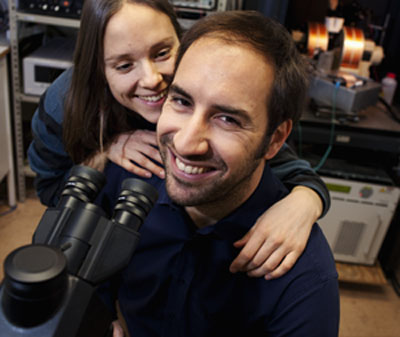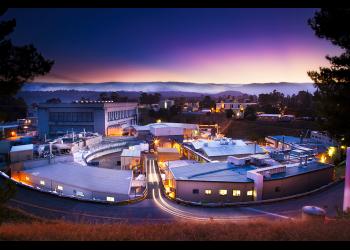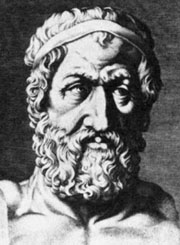A Man of Magnetism
PROFILE
Physicist Stefano Bonetti prepares to move from KTH to Stanford on a two-year post-doctoral fellowship studying the smallest and fastest magnetic phenomena known to science.

For a young researcher still in the early stages of a highly promising career in modern physics, Stefano Bonetti might seem a bit hung up on some very old ideas. Ask him to explain his work and he’ll first want to tell you about Zeno of Elea, the fifth-century BCE Italian philosopher who stumped Aristotle himself with the paradox of how a flying arrow could simultaneously be in motion and occupy a fixed point in space.
If everything is motionless at every instant and time is entirely composed of instants, Zeno reasoned, then motion is impossible. The ancients knew that the paradox had a solution since arrows insisted on flying when shot from a bow, but it would take centuries — and Newton’s invention of differential calculus — for a satisfactory explanation.
“Understanding how objects move through time and space has fascinated humankind since the beginning of history,” Bonetti says. “My work focusses on magnetism and motion at the atomic scale — some of the tiniest and fastest phenomena known to science.”
Bonetti, born and raised in Italy and holding a PhD from the KTH Department of Materials Physics, begins a two-year post-doctoral fellowship in February at Stanford University in California, financed by grants from the Swedish Research Council and the Knut and Alice Wallenberg Foundation. Together with his new wife, Karin Båge, who is pursuing a master’s degree in anthropology, his most urgent research interest for the moment is focussed on the notoriously tough Silicon Valley housing market. Married only a few weeks ago, the couple is frantically combing Internet listings in search of a California rental home — not an easy task from Stockholm.
After getting settled in the next few weeks, Bonetti will join a research group working with Stanford’s synchrotron accelerator to study magnetic actions measured in nanometer sizes and picosecond times. If all goes well, he says, the research could even get to the femtosecond scale.
To get an idea of how those scales relate to the “normal” Newtonian world in which we all live, consider this comparison: a femtosecond is to a second as a second is to 31.7 million years. It takes one thousand femtoseconds to make a picosecond, and even then we’re talking about one-trillionth of a second.
“We know that Newtonian physics doesn’t apply at the nano scale, but we don’t really know why,” explains Bonetti. “We can describe the physics to some extent, but the fundamental explanation for why nature doesn’t like to be Newtonian at the atomic scale is still a mystery. That question is going to keep scientists busy for many years.”
X-ray bombardment

Bonetti will join a team at the Pulse Institute for Ultrafast Energy Science — an independent laboratory at Stanford — to study the peculiar magnetic properties of exotic, laboratory-designed materials.
One group in the team will “grow” these materials by placing chunks of pure elements in a vacuum chamber and blasting them with high-energy radiation, typically from a laser, to create a cloud of individual atoms that then settle on a substrate as a film only a few atoms thick. By alternating this process using different elements in layers, the growers create “thin film” materials just tens or hundreds of atoms in depth and unlike anything occurring in nature.
Bonetti will work primarily with the second group, which plans to subject these new materials to intense bombardment by X-rays generated in the synchrotron, setting off bursts of extremely rapid atomic activity. It all happens far too fast to be seen directly by any instrument, but the process generates vast volumes of data that can be interpreted and modelled by computers to gain a better understanding of precisely what takes place during the almost infinitesimally tiny amount of time it takes for a magnetic force to change from one state to another.
Physicists have long used X-rays to study the fundamental properties of matter, such as atomic composition, crystal structure, valence state and magnetic configuration. But, as in all good science, each discovery leads to new questions, and recent developments in synchrotron technology now make it possible to generate X-ray pulses just a few femtoseconds long and focused within a few nanometers, opening up entirely new fields of research in condensed matter physics.
“Other scientists have already reached the point where they can look at a magnetic property in State A, and then see that the X-rays cause it to shift to State B,” Bonetti explains. “This study is about seeing the path it takes from A to B during these short time intervals.”
Describing himself as “much more a physicist than an engineer,” Bonetti says he’s motivated by a desire to unveil new basic knowledge, not to create commercial products. But that doesn’t stop him from speculating on how studies of nano-scale magnetic behaviour may someday have practical applications.
“Computer chip makers are very close to the physical limits of how much can be squeezed into silicon. They’re aggressively looking at other materials now, and no one can say where they’ll be in just five years,” he says. “The basic function of a transistor is very simple. You have a gate, and by opening or closing it you create your binary logic. What if we can use magnetism to define on and off? That might give us ‘smart,’ multifunctional materials.”
Unlike today’s electron-based technologies, magnetism stays in a given state without a continuous energy supply. “We might see laptop computers or other electronic devices that only need to be charged once a year.

“My work at Stanford is a purely experimental study on exotic materials,” Bonetti continues. “It’s very basic science. But the biggest technology revolutions usually begin with fundamental science. The transistor was very much a theoretical game when it was created at Bell Labs. And the technology behind today’s hard disks began with theories that only physicists understood — and even they didn’t quite see the practical value for some time.”
Just like Zeno and Aristotle, who weren’t looking to improve arrow technology, but only wanted to explain why they could fly at all.
By Kevin Billinghurst | kb2@kth.se

